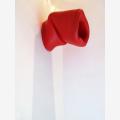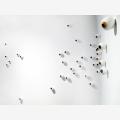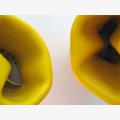
Visit Us
#1 Jila Alley, Basiri St. Gholhak
Shariati Ave. IRAN TEHRAN
TEL: (0098-21) 22 60 54 65
#1 Jila Alley, Basiri St. Gholhak
Shariati Ave. IRAN TEHRAN
TEL: (0098-21) 22 60 54 65
OFFICE
VILLA 21, 4B ST. , AL HUDAIBA 322 -
MARSAM MATTAR ART CENTER
Dubai - United Arab Emirates
La Beance ( فارسی )
SEND TO A FRIEND!Writen By translated: Hamidreza Karami
“Trauma” means “a wound” in Greek and in another sense it means being suddenly and unexpectedly exposed to a reality. A reference to the past and to events that act as stations of accentuation and a phenomenon that abruptly comes to a person’s notice, can give birth to a trauma.
Mahsā Karimizādeh received her first shock when she was thirteen, the after-effect of which has remained to this day as a crack or wound in her “woman-child” nature that grows deeper and turns to an open wound inside her “woman-young adult.” Trying to trace and make visible the hidden pit (La Beance), confronting the questions of life and death, to find the reasons for living and dying, leads the woman to the paradigm of Deep Dark (2007); and references to time-space emerge in some of her works which are developed as folded layers of object and space. They are the result of a philosophical longing in her mental journeys versus the realities of the world; and the “micro cosmos” and “macro cosmos” in this era, and her installations, is a poetic joy, in awe of the endlessness and majesty of the universe. If the artist feels weighty, it is because of a poetic idea that places the woman on the platform of unity of productivity—an ever-changing phenomenon that flows inside and outside of her at each and every moment. Today we are visiting an exhibition with two-sided and layered works. Firstly, after the long journey in the external world, we are standing face to face with her internal journey. Now the answer shall be found within, and shall be made visible in three-dimensional forms and structures: as volumes with cavities; deep invisible cavities or La Beance. Secondly, these statues are made of layers that are folded from the inside, so there’s meaning concealed within them. And a third aspect is that the artist, in order to get close to the reality of the forms within her, has made an attempt to use polymer to suggest the quality of human flesh and skin. During this process, she translates the viewer to a different understanding of forms and genders. It is as if Mahsā wants to send a camera inside her body, so, like Mona Hatoum, she can film her feminine inside. Mona Hatoum’s attitude is a kind of proclamation of a social identity though; but Mahsā Karimizādeh, without showing any particular concern for second- or third-wave feminism, is searching for her own truth and trying to discover the orbits inside her. Throughout this journey, she is not seeking a philosophical or mystical challenge or discourse. She is merely a voyager that has started her journey from the inside world: a journey to the amazing cavities inside her body; as if someone or something is hiding at every vestibule and opening. The ambience of the works of Argentinean visual artist, Ernest Neto, is also like inside world of human body that is made of translucent and white glands. His installations take up the inside room and remain hanged or in works of Anish Kapoor after his divergent and convergent they turn to bean-like volumes and invites the viewer to discover his outside and inside. One thing is obvious though: she is not far from this universal language. She shows no fear to discover her inside: to discover the woman inside her and her boldness; although this might be considered a taboo in the contemporary social milieu. The lively colors that Mahsā Karimizādeh uses to cover her volumes, in addition to the color-values she makes use of, are fascinating mediums that can help the viewer forget the darkness of the Deep Dark and black holes that exist in the eternal constructions of natural micro and macro cosmoses, within and without.
M. B. Zia’i, Art and Media magazine,
Critique and Editor-in-chief


